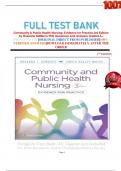Community & Public Health Nursing: Evidence for Practice 3rd Edition
by Rosanna DeMarco PhD Questions And Answers Graded A+
PRINTEND PDF|ORIGINAL DIRECT FROM PUBLISHER|100%
VERIFIED ANSWERS|DOWLOAD IMMEDIATELY AFTER THE
ORDER
3TH EDITION
Complete Test Bank, All Chapter Are Included
For More Documents Search (Testbankproferssor.Stuvia)
Page 1
, Table Of Contents
Chapter 1- Public Health Nursing -Present, Past And Future
Chapter 2- Public Health System
Chapter 3- Health Policy, Politics, And Reform
Chapter 4- Health And The Global Environment, 1
Chapter 5- Frameworks For Health Promotion, 2
Chapter 6- Epidemiology- The Science Of Prevention
Chapter 7- Describing Health Conditions
Chapter 8- Gathering Evidence For Public Health Practice
Chapter 9- Planning For Community Change
Chapter 10- Culture Diversity And Values
Chapter 11- Community Assessment
Chapter 12- Care Management, Case Management
Chapter 13- Family Assessment
Chapter 14- Risk Of Infectious And Communicable Diseases
Chapter 15- Emerging Infectious Diseases
Chapter 16- Violence And Abuse
Chapter 17- Substance Use
Chapter 18- Underserved Populations
Chapter 19- Environmental Health
Chapter 20- Community Preparedness- Disaster And Terrorism,
Chapter 21- Community Mental Health,
Chapter 22- School Health
Chapter 23- Faith-Oriented Communities And
Health Chapter 24- Palliative And End-Of-Life
Care Chapter 25- Occupational Health Nursing
Page 2
, Chapter 1- Public Health Nursing -Present, Past And Future
1. A Nurse Is Striving To Practice Patient-Centered Care At A Hospital. Which
Action Best Exemplifies Providing Patient-Centered Care?
A) Having A Client Complete A Self-Reported Functional Status Indicator
And Then Reviewing It With The Client
B) Explaining To A Client The Benefits Of Computer-Assisted Robotic
Surgical Techniques, Which The Hospital Recently Implemented
C) Recording A Client's Signs And Symptoms In An Electronic Health Record
D) Performing Continuous Glucose Monitoring Of A Client While The Client Is
In The Hospital
Ans: A
Feedback:
Patient-Centered Care Considers Cultural Traditions, Personal Preferences, Values,
Families, And Lifestyles. Clients Become Active Participants In Their Own Care, And
Monitoring Health Becomes The Client's Responsibility. To Help Clients And Their
Healthcare Providers Make Better Decisions, The Agency For Healthcare Research
And Quality (Ahrq) Has Developed A Series Of Tools That Empower Clients And
Assist Providers In Achieving Desired Outcomes, Including Client-Reported
Functional Status Indicators. Computer-Assisted Robotic Surgical Techniques,
Electronic Health Records, And Continuous Glucose Monitoring In The Hospital Are
All Technological Advances In Healthcare, But They Do Not Help The Client Become
A More Active Participant In His Or Her Care, And Thus Are Not Good Examples Of
Patient-Centered Care.
Origin: Chapter 1- Public Health Nursing, 2
2. A Nurse Is Caring For An Older Client Who Is Struggling To Manage Her Type 2
Diabetes Mellitus. The Nurse Should Recognize Which Social Determinants Of This
Client's Health? (Select All That Apply.)
A) Household Income Of $23,000 Per Year
B) Reading Level Of A Third Grader
C) Medication Ineffective Due To Error In Prescription
D) Originally From Sudan
E) No Family In The
Area Ans: A, B, D, E
Feedback:
The Social Conditions In Which People Live, Their Income, Social Status, Education,
Literacy, Home And Work Environment, Support Networks, Gender, Culture, And
Availability Of Health Services Are The Social Determinants Of Health. These
Conditions Have An Impact On The Extent To Which A Person Or Community
Possesses The Physical, Social, And Personal Resources Necessary To Attain And
Maintain Health. A Medical Error On The Part Of The Client's Primary Care Provider
Or Nurse Would Not Constitute A Social Determinant Of The Client's Health.
Page 3
, origin: chapter 1- public health nursing, 3
3. a nurse successfully persuades an obese client to perform a weekly weigh-in at home
using a digital scale and record the weight in a log. this strategy is an example of:
A) telehealth
B) health information technology
C) personal responsibility for health
D) evidence-based nursing
ans: c
feedback:
personal responsibility for health involves active participation in one's own health
through education and lifestyle changes. in this case, the client makes a positive change
in lifestyle by monitoring body weight weekly. telehealth is the use of electronic
information and telecommunications technologies to support long-distance clinical
healthcare, client and professional health-related education, public health, and health
administration. health information technology (hit) is defined as the comprehensive
management of health information and its exchange between consumers, providers,
government, and insurers in a secure manner. evidence-based nursing is the integration
of the best evidence available with clinical expertise and the values of the client to
increase the quality of care.
origin: chapter 1- public health nursing, 4
4. a nurse performs a variety of tasks as part of the nurse's position at a hospital. which
task best exemplifies public health?
A) reading current nursing journals and integrating the latest research into daily
practice
B) instructing a client on how to best care for a suture site at home
C) participating in a videoconference call with a client who lives in a remote area
D) facilitating a community-wide smoking cessation program one month out of the
year
ans: d
feedback:
public health is what society does collectively to ensure the conditions exist in which
people can be healthy. a community-wide smoking cessation program is a great
example of a public health intervention, in that it involves the collective effort of society
to improve the health of its members. reading and applying the latest nursing research is
an example of evidence-based nursing. instructing a client on how to best care for a
suture site at home is an example of personal responsibility for health, but it is not
focused on the health of the greater community. participating in a videoconference call
with a client who lives in a remote area is an example of patient-centered care and of an
effective implementation of technology, but it is not particularly related to public health.
Page 4




